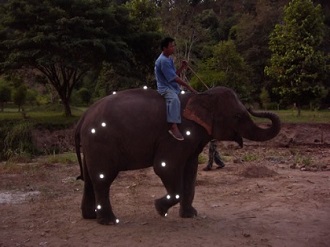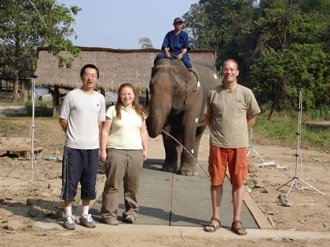
Biomechanical Research Revealing Elephants Move Like 4x4 Vehicles
The RVC Structure and Motion Laboratory group took up the challenge of understanding how and why elephants move as they do in the late 1990s and has produced extensive research on the subject over the intervening decades.
Challenge
Researchers have been puzzled about how elephants move since Edward Muybridge first caught their “ambling” gait on film as part of his major contribution (with Etienne-Jules Marey) to the invention of cinematography. Elephants can move somewhat quickly but never leave the ground with all four feet at once. Professor John Hutchinson of the RVC took up the challenge of understanding this decades ago and have been progressing research into it since then, spanning elephant anatomy, growth and locomotion.

Solution
Professor Hutchinson and his team’s latest study is a climax of much of those decades of research. Hutchinson’s team, including first author Dr Lei Ren, former PhD student Dr Charlotte Miller, and long-time collaborator in Thailand Richard Lair (of the Thai Elephant Conservation Centre and National Elephant Institute), published a paper in Proceedings of the National Academy of Sciences (PNAS) entitled ‘Integration of biomechanical compliance, leverage, and power in elephant limbs.’ PNAS is a very prestigious international science journal based in the USA.
In 2006, Dr Hutchinson's team conducted a series of challenging experiments in Thailand where they installed 16 ‘elephantine’ force platforms in the ground. They then had six Asian elephants traverse the force platforms across a wide range of speeds (from slow walking to about 11 mph, approaching their top speed of 15mph; 24kph). The force platforms measured the forces on elephant limbs while seven high-speed infrared motion capture cameras recorded their movements. This is no simple endeavour, but they were lucky enough to be able to share these custom-made forceplates with a research team from Belgium. The team had to work at twilight because their cameras were very sensitive to the strong Thai sunlight.
Dr Hutchinson's team used these analyses, in addition to anatomical dissections of elephants that had died in captivity from unrelated causes, to address three related questions about how elephants move. These are addressed below:

Are elephant limbs like pillars?
Elephant limbs are compliant (showing elastic or bouncy aspects) even in walking, against classical dogma that they are stiff and columnar. Elephant limbs are often described as the epitome of a pillar-like limb structure for supporting their weight. Dr Hutchinson's team found that elephant limbs bend and rebound small amounts during each step, acting less like pillars than previously thought and more like bouncy struts. This compliance seems to help keep the forces on elephant limbs low, acting like a shock absorber, which is important for such large animals.
Do elephant limbs have the best leverage of any land animal?
Previous theory held that animals tend to adopt straighter limb postures as they get larger during evolution, which helps to improve their leverage and provide them with more efficient support of their weight. Dr Hutchinson's team used this theory to predict how good the leverage of elephant limbs should be and found that it was only one third to one half as good as predicted. Indeed, elephant limb leverage is worse than that of horses and almost precisely the same as humans. Also like humans, and unlike horses and other quadrupeds, elephant limb leverage gets worse as they speed up from a walk to a run. This means that when running, elephant muscles must work even harder to prevent the limbs from collapsing than they otherwise might. Their compliance (bounciness) may help alleviate this problem. However, the study showed that the metabolic costs of running in elephants might get so high that endurance would become a major problem, which may be why elephants seem not to run often or for very long. This link between leverage and metabolic cost had not been shown before in elephants and could only be determined with these measurements.
Do elephants use their limbs to propel and brake their mass in the same way as smaller animals?
Four-legged animals divide the labour between their fore and hind limbs during walking and running. The forelimbs mainly brake the animal and the hindlimbs mainly propel it. Together they help the whole animal maintain a steady speed. So when the RVC team measured these braking and propulsive forces in elephants, they were surprised to find that this division of labour was absent. Elephant fore and hind limbs did similar things – they all contributed to braking and propulsion, not predominantly one or the other. Thus elephants use their limbs like the wheels of 4x4 vehicles, which should help them to maintain a steady speed at low cost, with a smooth ride. As far as we know, this way of moving is unique to elephants.
Impact
The research is useful as it is basic science that is about how elephant limbs function, at a fundamental level, and this is interesting and important in itself, for many reasons (probably some of which no one can predict). But the data we have collected are precisely the kind of data routinely used in human (and other animal) clinical/orthopaedic gait studies to compare normal and abnormal individuals, for example with arthritis or foot problems. Because elephants experience similar health problems, our data forms a useful (and to date the only) baseline for beginning to understand how, why and when elephants develop musculoskeletal health problems that have an underlying biomechanical basis.
We also reveal some factors influencing metabolic costs in elephants, which ultimately could help understand their migrations and even aid in conservation. This is a long way off but would depend on analyses like ours.
Funder and Partners
Biotechnology and Biological Sciences Research Council (BBSRC)
Special thanks are due to Mr. Daniel Seng (Qualisys, Inc.) and Mr. Thanasit Ujjin (United Sports Trading Pvt, Ltd.) for loans of Qualisys ProReflex motion analysis cameras in Thailand.
Publications
| Title | Publication | Year |
| Integration of biomechanical compliance, leverage, and power in elephant limbs | Proceedings of the National Academy of Sciences USA | 2010 |
News / In the media
Scientific American – Elephants Divvy up the Leg Work
The Independent – The Natural World's Very Own 4x4s
The Metro – Elephants ‘Walk Like Land Rovers’, Say Scientists
ABC Science – Elephants Move Like a 4x4
New Zealand Herald – Elephants’ Walking Style Goes Out on a Limb
